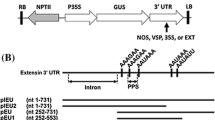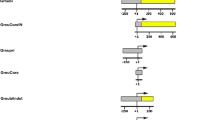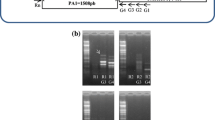Abstract
The first intron (EPI) of rice 5-enolpyruvylshikimate 3-phosphate synthase gene was isolated by PCR from one clone with genomic EPSP synthase gene. Sequence analysis showed that the first intron is 704 bp in length with 36.2% G+C content. To investigate its effect on expression of foreign gene, we inserted the first intron between CaMV35S promoter and β-glucuronidase (GUS) gene. The transient expression results showed that GUS could be expressed effectively with EPI. The GUS activity in transgenic tobacco shows that the EPI can greatly enhance the expression level of β-glucuronidase (P < 0.01) compared with transgenic tobacco without the first intron, and 3-to 6-fold increase in GUS activity in some transgenic tobaccos. Northern blot indicated the first intron was spliced from GUS pre-mRNA, and the steady-state mRNA levels of GUS with EPI in transgenic tobaccos were higher than that in transgenic tobacco without EPI, which suggested that the first intron of EPSP was a non-translated intron.
Similar content being viewed by others
References
de Souza, S. J., Long, M., Gilbert, W., Introns and gene evolution, Genes Cells, 1996, 1(6): 493–505.
Buchman, A. R., Berg, P., Comparison of intron-dependent and intron-independent gene expression, Mol. Cell Biol., 1988, 8(10): 4395–4405.
Brinster, R. L., Behringer, R. R., Gelinas, R. E. et al., Introns increase transcriptional efficiency in transgenic mice, Proc. Natl. Acad. Sci. USA, 1988, 85(3): 836–840.
Callis, J., Fromm, M., Walbot, V., Introns increase gene expression in cultured maize cells, Genes Dev., 1987, 1(10): 1183–1200.
Luehrsen, K. R., Walbot, V., Intron enhancement of gene expression and the splicing efficiency of introns in maize cells, Mol. Gen. Genet., 1991, 225: 81–87.
Maas, C., Laufs, J., Grant, S. et al., The combination of a novel stimulatory element in the first exon of the maize Shrunken-1 gene with the following intron 1 enhances reporter gene expression up to 1000-fold, Plant Mol. Biol., 1991, 16(2): 199–207.
McElory, D., Zhang, W., Cao, J. et al., Isolation of an efficient actin promoter for use in rice transformation, Plant Cell, 1990, 2(2): 163–171.
Xu, Y., Yu, H., Hall, T. C., Cytosolic triosephosphate isomerase is a single gene in rice, Plant Physiol., 1993, 101(2): 683–687.
Dean, C., Favreau, M., Bond-Nutter, D. et al., Sequences downstream of translation start regulate quantitative expression of two petunia rbcS genes, Plant Cell, 1989, 1(2): 201–208.
Leon, P., Planckaert, F., Walbot, V., Transient gene expression in protoplasts of Phaseolus vulgaris isolated from a cell suspension culture, Plant Physiol., 1991, 95: 968–972.
Norris, S. R., Meyer, S. E., Callis, J., The intron of Arabidopsis thaliana polyubiquitin genes is conserved in location and is a quantitative determinant of chimeric gene expression, Plant Mol. Biol., 1993, 21(5): 895–906.
Zhang, S. H., Lawton, M. A., Hunter, T., atpk1, a novel ribosomal protein kinase gene from Arabidopsis (I)-Isolation, characterization, and expression, J. Biol. Chem., 1994, 269(26): 17586–17592.
Rose, A. B., Last, R. L., Introns act post-transcriptionally to increase expression of the Arabidopsis thaliana tryptophan pathway gene PAT1, Plant J., 1997, 11(3): 455–464.
Gollub, E., Zackin, H., Sprinson, D. B., Correlation of genes and enzymes, and studies on regulation of the aromatic pathway in Salmonella, J. Biol. Chem., 1967, 242(22): 5323–5328.
Ren, Y. G., Yu, X. L., Shan, S. et al., Transient uid A gene expression in tobacco chloroplasts by induction of the rice psbA promoter, J. Agri. Biotech. (in Chinese), 1995, 3(4): 78–83.
Gao, Y. F., Zhu, Z., Xiao, G. F. et al., Isolation of soybean kunitz trypsin inhibitor gene and its application in plant insect-resistant genetic engineering, Acta Botanica Sinica, 1998, 40: 405–411.
Chomezyshi, P., Sacchi, N., Single-step method of RNA isolation by acid guanidinium thiocyanate-phenol-chloroform extraction, Anal. Biochem., 1987, 162: 156–159.
Sambrook, J., Russell, D. W., Molecular Cloning: A Laboratory Manual, 3rd ed., New York: Cold Spring Harbor Laboratory Press, 2001.
Jefferson, R. A., Kavanagh, T. A., Bevan, M. W., GUS fusions: Beta-glucuronidase as a sensitive and versatile gene fusion marker in higher plants, EMBO J., 1987, 6(13): 3901–3907.
Simpson, C. G., McQuade, C., Lyon, J. et al., Characterization of exon skipping mutants of the COP1 gene from Arabidopsis, Plant J., 1998, 15(1): 125–131.
Steinrücke, H. C., Amihein, N., The herbicide glyphosate is a potent inhibitor of 5-enolpyruvyl-shikimic acid-3-phosphate synthase, Biochem. Biophys. Res. Commun., 1980, 94(4): 1207–1212.
Xu, J. W., Feng, D. J., Li, X. G. et al., Cloning of genomic DNA of rice 5-enolpyruvylshikimate 3-phosphate synthase gene and chromosomal localization of the gene, Science in China, Ser. C, 2002, 32(2): 97–104.
Xu, J. W., Wei, X. L., Li, X. G. et al., Isolasion of rice EPSP synthase cDNA and its sequence analysis and copy number determination, Acta Bota Sinica, 2002, 44(2): 188–192.
Bornstein, P., Mckay, J., Liska, D. J. et al., Interactions between the promoter and first intron are involved in transcriptional control of alpha 1(I) collagen gene expression, Mol. Cell Biol., 1988, 8(11): 4851–4857.
Brooks, A. R., Nagy, B. P., Taylor, S. et al., Sequences containing the second-intron enhancer are essential for transcription of the human apolipo protein B gene in the livers of transgenic mice, Mol. Cell Biol., 1994, 14(4): 2243–2256.
Huang, M. T., Gorman, C. M., The simian virus 40 small-t intron, present in many common expression vectors, leads to aberrant splicing, Mol. Cell Biol., 1990, 10(4): 1805–1810.
Xie Xianzhi, Wu Naihu, Isolation of tomato proteinase inhibitor II gene and the function of its intron, Chin. Sci. Bull., 2002, 47(10): 830–834.
Author information
Authors and Affiliations
Corresponding author
Rights and permissions
About this article
Cite this article
Xu, J., Feng, D., Song, G. et al. The first intron of rice EPSP synthase enhances expression of foreign gene. Sci. China Ser. C.-Life Sci. 46, 561–569 (2003). https://doi.org/10.1360/02yc0120
Received:
Issue Date:
DOI: https://doi.org/10.1360/02yc0120




